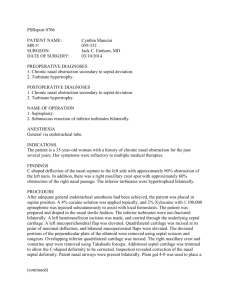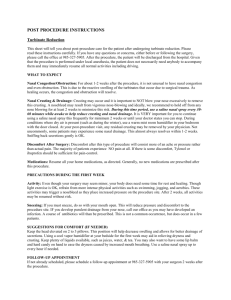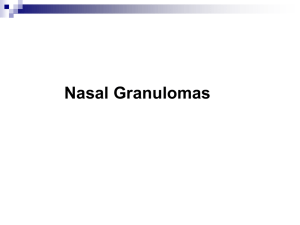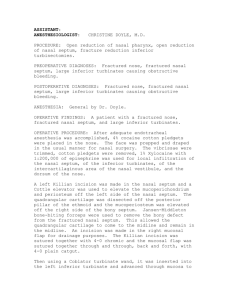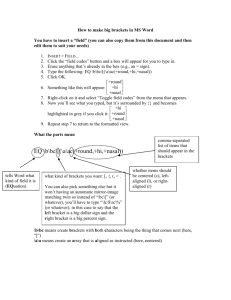The Effect of Sub-Mucosal Diathermy in Chronic Nasal Obstruction
advertisement
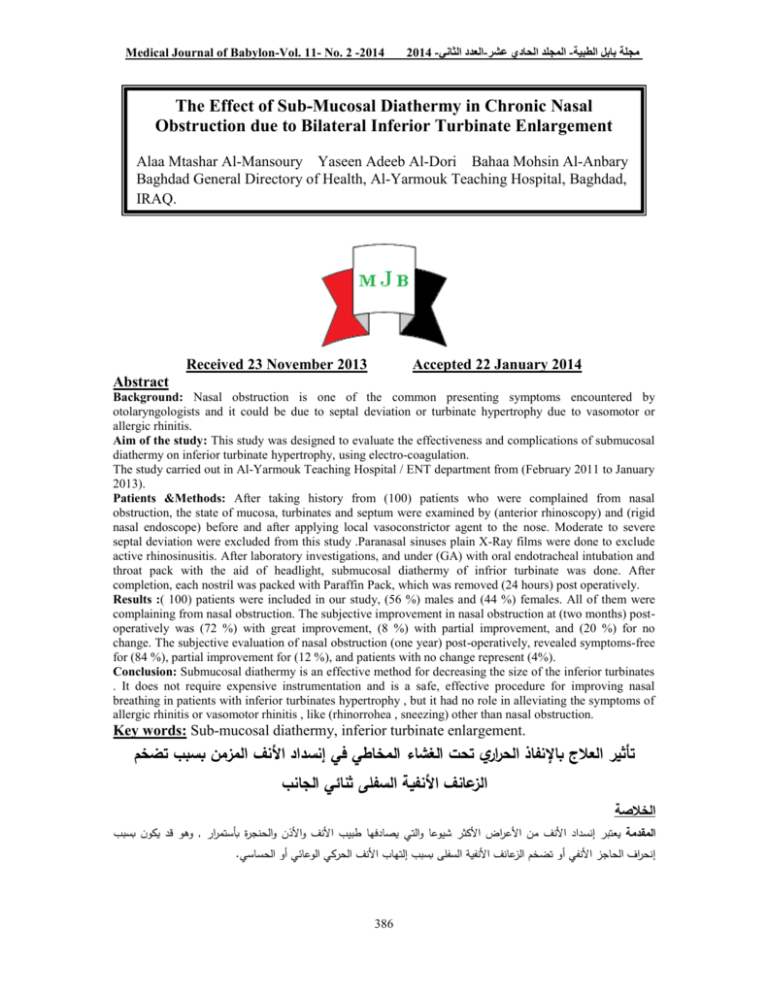
Medical Journal of Babylon-Vol. 11- No. 2 -2014 2014 -العدد الثاني- المجلد الحادي عشر-مجلة بابل الطبية The Effect of Sub-Mucosal Diathermy in Chronic Nasal Obstruction due to Bilateral Inferior Turbinate Enlargement Alaa Mtashar Al-Mansoury Yaseen Adeeb Al-Dori Bahaa Mohsin Al-Anbary Baghdad General Directory of Health, Al-Yarmouk Teaching Hospital, Baghdad, IRAQ. Received 23 November 2013 Accepted 22 January 2014 Abstract Background: Nasal obstruction is one of the common presenting symptoms encountered by otolaryngologists and it could be due to septal deviation or turbinate hypertrophy due to vasomotor or allergic rhinitis. Aim of the study: This study was designed to evaluate the effectiveness and complications of submucosal diathermy on inferior turbinate hypertrophy, using electro-coagulation. The study carried out in Al-Yarmouk Teaching Hospital / ENT department from (February 2011 to January 2013). Patients &Methods: After taking history from (100) patients who were complained from nasal obstruction, the state of mucosa, turbinates and septum were examined by (anterior rhinoscopy) and (rigid nasal endoscope) before and after applying local vasoconstrictor agent to the nose. Moderate to severe septal deviation were excluded from this study .Paranasal sinuses plain X-Ray films were done to exclude active rhinosinusitis. After laboratory investigations, and under (GA) with oral endotracheal intubation and throat pack with the aid of headlight, submucosal diathermy of infrior turbinate was done. After completion, each nostril was packed with Paraffin Pack, which was removed (24 hours) post operatively. Results :( 100) patients were included in our study, (56 %) males and (44 %) females. All of them were complaining from nasal obstruction. The subjective improvement in nasal obstruction at (two months) postoperatively was (72 %) with great improvement, (8 %) with partial improvement, and (20 %) for no change. The subjective evaluation of nasal obstruction (one year) post-operatively, revealed symptoms-free for (84 %), partial improvement for (12 %), and patients with no change represent (4%). Conclusion: Submucosal diathermy is an effective method for decreasing the size of the inferior turbinates . It does not require expensive instrumentation and is a safe, effective procedure for improving nasal breathing in patients with inferior turbinates hypertrophy , but it had no role in alleviating the symptoms of allergic rhinitis or vasomotor rhinitis , like (rhinorrohea , sneezing) other than nasal obstruction. Key words: Sub-mucosal diathermy, inferior turbinate enlargement. تأثير العالج بال فناا الحراري تحت الغشاء المخاطي في إفنسداد األفنف المزمن بسبب تضخم الزعافنف األفناية السالى ثفنائي الجافنب الخالصة وهو قد يكون بسبب, المقدمة يعتبر إنسداد األنف من األعراض األكثر شيوعا والتي يصادفها طبيب األنف واألذن والحنجرة بأستمرار .إنحراف الحاجز األنفي أو تضخم الزعانف األنفية السفلى بسبب إلتهاب األنف الحركي الوعائي أو الحساسي 386 مجلة بابل الطبية -المجلد الحادي عشر-العدد الثاني2014 - Medical Journal of Babylon-Vol. 11- No. 2 -2014 خلاية الهدف انجزت هذه الدراسة لتقييم فعالية ومضاعفات اإلنفاذ الحراري للطبقة تحت المخاطية للزعانف األنفية السفلى بإستعمال التخثير الكهربائي وقدأعدت في مستشفى اليرموك التعليمي /شعبة جراحة األنف واألذن والحنجرة للفترة من شباط 2011الى كانون الثاني . 2013 المرضى وطرق العمل أن هذه الدراسة هي دراسة منظوره تضمنت مئة مريض .بعد أخذ التأريخ المرضي من ( ) 100مريض والذين يشكون من إنسداد األنف,تم فحصهم جميعابواسطة(الناظور األمامي لألنف)و(والناظور األنفي الصلب – 4ملم – درجة الصفر)قبل وبعد تقطير قطرات إنقباض األوعية (زايلوميتازولين ) %0,1في األنف .تم فحص الغشاء المخاطي والزعانف االنفية والحاجز األنفي .لم تشمل الدراسة المرضى الذين لديهم أنحراف الحاجز األنفي المتوسط والشديد .أجريت للمرضى أشعة أكس لفحص الجيوب األنفية إلستثناء أي إلتهابات جيبية أنفية حادة .وقد تم تطبيق معايير اإلدراج واإلستثناء على المرضى والذين كانوا يعانون من إنسداد األنف بسبب تضخم الزعانف األنفية السفلى وتم أختيار ( )100مريضا .وبعد التحريات المختبرية المناسبة ,تم إجراء عملية اإلنفاذ الحراري للزعانف األنفية السفلى تحت التخدير العام . الفنتائج شملت دراستنا( ) 100مريضا )%56(,ذكور)%44( ,إناث ,وجميعهم يعانون من إنسداد األنف .بالنسبة للتحسن الذاتي للتنفس األنفي بعد ( شهرين ) من عملية األنفاذ الحراري للزعانف األنفية السفلى ,كانت النتائج ( %72تحسن كبير ) و ( %8تحسن جزئي )و( %20بال تغيير).أما بالنسبة للتقييم الذاتي للتنفس األنفي بعد( سنة)من العملية ,فقد أظهر نسبة( %84بال أعراض )و( %12تحسن جزئي) و( %4بال تغيير). الستفنتاج عملية اإلنفاذ الحراري عملية فعالة لتقليص حجم الزعانف األنفية السفلى ,والتحتاج الى أدوات مكلفة ,وهي مأمونة وفعالة لتحسين التنفس األنفي بالنسبة لمرضى تضخم الزعانف األنفية السفلى .والمرضى الذين يستفيدون من هذه العملية هم الذين يكون لديهم تحسن وقتي لإلنسداد الهوائي بعد إستعمال قطرات إنقباض األوعية الدموية (زايلوميتازولين .)% 0,1وهذه العملية ليس لها دور في تسكين أعراض إلتهاب األنف الحركي الوعائي والحساسي(السيالن األنفي والعطاس )عدا أنسداد األنف. ـ ـ ـ ـ ـ ـ ـ ـ ـ ـ ـ ـ ـ ـ ـ ـ ـ ـ ـ ـ ـ ـ ـ ـ ـ ـ ـ ـ ـ ـ ـ ـ ـ ـ ـ ـ ـ ـ ـ ـ ـ ـ ـ ـ ـ ـ ـ ـ ـ ـ ـ ـ ـ ـ ـ ـ ـ ـ ـ ـ ـ ـ ــ ـ ـ ـ ـ ـ ـ ـ ـ ـ ـ ـ ـ ـ ـ ـ ـ ـ ـ ـ ـ ـ ـ ـ ـ ـ ـ ـ ـ ـ ـ ـ ـ ـ ـ ـ ـ ـ ـ ـ ـ ـ ـ ـ ـ ـ ـ ـ ـ ـ ـ ـ ـ ـ ـ ـ ـ ـ ـ ـ ـ ـ ـ ـ ـ ـ ـ ـ ـ ـ ـ ـ ـ ـ ـ ـ ـ ـ ـ ـ ـ ـ ـ ـ ـ ـ ـ ـ ـ ـ ـ ـ ـ ـ ـ ـ ـ ـ ـ ـ ـ ـ ـ ـ ـ ـ ـ ـ ـ ـ ـ ـ ـ ـ ـ ـ ـ ـ ـ ـ ـ ـ ـ ـ ـ ـ ـ ــ ـ ـ ـ ـ ـ ـ ـ ـ ـ ـ ـ ـ ـ ـ ـ ـ ـ ـ ـ ـ ـ ـ ـ ـ ـ ـ ـ ـ ـ ـ ـ ـ ـ ـ ـ ـ ـ ـ ـ ـ ـ ـ ـ ـ ـ ـ ـ ـ ـ ـ ـ ـ ـ ـ ـ ـ ـ ـ ـ ـ ـ ـ ـ ـ ـ ـ ـ ـ ـ ـ ـ ـ ـ ـ ـ ـ ـ ـ ـ ـ ـ ـ ـ ـ ـ ـ ـ ـ ـ ـ ـ ـ ـ ـ ـ ـ ـ ـ ـ ـ ـ ـ ـ ـ ـ ـ ـ ـ ـ ـ ـ ـ of them were failed to respond to medical treatment for a long period of time (months to years). After applying (Xylocaine spray 10 % to both nostrils), all patients were examined ( before and after applying local vasoconstrictor drops – Xylometazoline 0.1% - to both nostrils ) by ( Anterior Rhinoscopy ) and ( Rigid Nasal Endoscope – 4 mm – 0 ) degree Inclusion criteria for the patient: 1. Nasal obstruction due to inferior turbinate hypertrophy. 2. Mucosal hypertrophy of both inferior turbinates refractory to medical treatment. 3. Non-complicated allergic rhinitis and vasomotor rhinitis. Exclusion criteria: 1. Moderate to Severe septal deviation. 2. Active rhinosinusitis. 3. Previous nasal surgery. 4. Nasal polyp, middle turbinate enlargement. Introduction asal obstruction is one of the common presenting symptoms encountered by otolaryngologists and it could be due to septal deviation or turbinate hypertrophy due to vasomotor or allergic rhinitis. N Aim of the Study To evaluate the effectiveness and complications of submucosal diathermy on inferior turbinate hypertrophy, using electro-coagulation. Patients and Methods Selection of Patients Depending on the history and physical examination, we select (100) patients who had suffered from nasal obstruction, they were seen and evaluated in the outpatient clinic of otolaryngology in AL-Yarmouk teaching hospital between February 2011 and January 2013 and they had been submitted to clinical and endoscopic examination of the nose all 387 Medical Journal of Babylon-Vol. 11- No. 2 -2014 5. Patients who get no relief of airway obstruction after application of local vasoconstrictor drops ( Xylometazoline 0.1%) Method The procedure was done, under general anaesthesia with oral endotracheal intubation and throat pack with the aid of headlight. A- Premedication: Topical nasal decongestant ( Xylometazoline 0.1% – 2 drops 3 times daily ) were given for (one week ) before the operation. B- Position: The patient is placed in reverse Trendlenberg position (head up 15degree) C- Preparation of the nose The procedure begins with the application of A cotton pledget impregnated with topical nasal decongestant agent ( Xylometazoline 0.1%) was applied before all procedures. D- Surgical technique: We used a nasal Killian speculum to view the anterior end of the inferior turbinate. A pointed probe (Tilley Lichtwitz antral trocars ) was used and touched by a unipolar coagulation diathermy device .It was inserted through the length of the inferior turbinate parallel to nasal floor until the posterior end was reached, then it was withdrawn slowly through the turbinate over a period of (10-20 seconds). Up to three passes of the probe was applied on the medial surface of the hypertrophied inferior turbinate. The procedure was repeated for the other inferior turbinate. After completion, each nostril was packed with Paraffin Pack, which was removed (24 hours) postoperatively. 2014 -العدد الثاني- المجلد الحادي عشر-مجلة بابل الطبية Post-operative care Post operatively , the patients were given (Systemic Antibiotics – as a prophylactic – Clavulanic acid 125 mg augmented Amoxicillin 500 mg – 1 tab. x 3) and (Analgesics – Paracetamole 1 tab x 3 ). No (local or Systemic Decongestants) were given to assess the effect of operation. At first month, Follow up was done (weekly). Then (monthly) for the next two months, then every (three months) for the next nine months. At each visit, the nose was examined by (anterior rhinoscopy - for any bleeding, congestion, edema, and adhesions). Crustations if present were removed. Also (spatula test & cotton wool test) were done to check nasal patency. We strongly instructed the patients to cease smoking and avoid exposure to chemical irritants. After (1 – 2 months), patients resume their usual treatment for allergic and vasomotor rhinitis. Results 1. Gender distribution: Male are more affected 56 patients (56%) than females 44 patients (44%). 2. Age Distribution: The commonest age group affected was between 21– 30 years (young adults) 44 patients (44%) while the least common age group affected was between 41– 55 years 12 patients (12%). 3. Duration of chief complaint: Most of the patients have duration of symptoms of 3 years 32 patients (32%). 4. Preoperative symptom (Patient’s Complaint): 388 Medical Journal of Babylon-Vol. 11- No. 2 -2014 Table 1 Patient`s Complaint Complaint Nasal obstruction Sneezing Rhinorrhea Affected by change of weather Cough Itching (ear/nose/throat) Sore throat Snoring Disturbed Sleep Loss of smell Headache 2014 -العدد الثاني- المجلد الحادي عشر-مجلة بابل الطبية No. of patients 100 80 64 64 Percentage ( %) 100 80 64 64 32 28 24 24 8 4 4 32 28 24 24 8 4 4 patients (36%) were found to be smokers. 6. Endoscopic findings: 5. Smoking and chemical irritants exposure: History of chemical irritants exposure was found in 64 patients (64%), while 36 Table 2 Endoscopic Findings (Pre-operatively) Findings No. of patients Pale mucosa 64 Congested edematous 36 mucosa Bilateral inferior turbinate 16 hypertrophy (moderate) Bilateral inferior turbinate 84 hypertrophy( marked) Septum ( straight ) 76 Septum ( mild deviation ) 24 Middle turbinate enlargement 7. X-Ray findings: Table 3 X-Ray Findings ( Pre-operatively ) Findings No. of patients Shadow of inferior 100 turbinate hypertrophy Sinus haziness or air fluid level 389 Percentage ( % ) 64 36 16 84 76 24 - Percentage ( % ) 100 - Medical Journal of Babylon-Vol. 11- No. 2 -2014 2014 -العدد الثاني- المجلد الحادي عشر-مجلة بابل الطبية Table 4 Subjective complaints of nasal obstruction ( Pre-operatively) State of Nasal Obstruction No. of Patients Percentage ( % ) Mild obstruction on 28 28 physical effort Moderate obstruction 56 56 on physical effort Obstruction at rest 16 16 Total 100 100 Table 5 Subjective effects of submucosal diathermy of inferior turbinates on nasal obstruction at (two months ) ( post-operatively) Effect on Nasal No. of Patients Percentage obstruction Great improvement 72 72 Partial improvement 8 8 No change 20 20 Total 100 100 Table 6 Subjective evaluation of nasal obstruction (one year) (post-operatively) Effect on Nasal No. of Patients Percentage ( % ) obstruction Symptoms-free 84 84 Partial improvement 12 12 No change 4 4 Total 100 100 Table 7 Subjective evaluation of symptoms ( other than post-operatively ) Complaint No. of (%) of patients pre- patients preop. op. Sore throat Snoring Disturbed sleep Rhinorrhea Loss of smell Headache Sneezing Itching (ear/nose/throat) Cough nasal obstruction )( 3 months ) ( 24 24 8 64 4 4 80 28 24 24 8 64 4 4 80 28 No. of (%) of relief patients post-op. relieved postop. 20 83.3 20 83.3 4 50 4 6.25 0 0 0 0 0 0 0 0 32 32 0 390 0 Medical Journal of Babylon-Vol. 11- No. 2 -2014 2014 -العدد الثاني- المجلد الحادي عشر-مجلة بابل الطبية Table 8 Congested mucosa ( post-operatively ) Duration No. of Patients 1 Week 60 2 Week 36 3 Week 20 1 Month 4 2 Month 3 Month - Percentage ( % ) 60 36 20 4 - Table 9 Oedema ( post-operatively ) Duration No. of Patients 1 Week 68 2Week 48 3 Week 28 1 Month 4 2 Month 3 Month - Percentage ( % ) 68 48 28 4 - Table 10 Crustations ( post-operatively ) Duration No. of Patients 1 Week 48 2 Week 36 3 Week 28 1 Month 12 2 Month 4 3 Month - Percentage ( % ) 48 36 28 12 4 - Table 11 ( Bleeding / Adhesion / Pain ) - post-operatively Complication No. of Patients Pain 16 Bleeding Adhesion Percentage ( % ) 16 - submucosal diathermy of inferior turbinates at (two months) postoperatively was (72 % ) with great improvement, (8 %) with partial improvement, and (20 %) for no change. Milo Fradis, MD, Shelton Malatskey, evaluated the results of their experience with (SMD) in ( two studies ) . In their first study ( 2000 ), on ( 51 ) patients suffering from chronic nasal obstruction. Discussion Great improvement in nasal obstruction (Two months) postoperatively: The mucosal congestion, oedema and crustation were the main cause of delayed improvement in nasal airway after the operation. In our study , the subjective improvement in nasal breathing by 391 Medical Journal of Babylon-Vol. 11- No. 2 -2014 They found that diathermy demonstrated good results in ( 78% ) of the cases at (2 weeks ) postoperatively and in ( 76% ) of the cases ( 2 months ) following the procedure . Patients who had no complaints and had good nasal airflow were not followed-up after 2 months[1]. In their second study ( 2002 ), on ( 91 ) patients , they have carried out a longterm follow-up . Patients were examined at ( 2 months ) postoperatively and after ( 1 year ), with both subjective and objective assessments of nasal breathing . ( Two months ) postoperatively (70.3%) experienced subjective improvement in nasal breathing, whereas (80.2%) had good nasal breathing as indicated with the Gertner-Podoshin plate [1]. Symptoms-free (regarding nasal obstruction) (One year) postoperatively: In our study , the subjective evaluation of nasal breathing ( one year ) postoperatively, revealed symptoms-free for ( 84 % ), partial improvement for ( 12 % ) , and patients with no change represent (4 %). Milo Fradis, MD, Shelton Malatskey , in their second study ( 2002 ) , on ( 91 ) patients , and during the follow-up year , secondary operations were deemed necessary for ( 16 ) patients because of unsatisfactory results of the original procedure ( so they were excluded from the study). At the (1-year) follow-up visit, (65 patients) (of the 75) were symptom-free with respect to nasal breathing (86.7 %) and (67 patients) (89.3%) had good nasal breathing as examined with the GertnerPodoshin plate[1]. Yaseen et al did a study on (40 patients) in the period from (August 2007 to November 2008), about (Thermal reduction of hypertrophied inferior 2014 -العدد الثاني- المجلد الحادي عشر-مجلة بابل الطبية turbinate) in Al-yarmouk Teaching Hospital / department of otolaryngology. (60 %) of the patients were males and (40 %) were females. Their age ranged from (18 – 50 years) with a mean age of (34 years), and all of them suffer from nasal obstruction. One month after the operation, relief of nasal obstruction was (75 %). Six months after the operation, the results were (85 %), while at the end of the twelve months the results were (75 %). [2] Benefit of SMD according to other studies (regarding nasal obstruction): Vonk Haake & N Piltardcastle PF. ( 1985 ), did a study on ( 60 ) patients who were operated on by submucosal diathermy of the inferior turbinate and were followed by questionnaire for periods ranging from ( 1 – 5 years ) since surgery . Their results revealed that surgery was of benefit in up to ( 72 % ) of cases [3]. Jones AS . , Lancer JM. ( 1987 ) found that submucosal diathermy was effective in the short term ( 2 months ) in reducing nasal resistances to air flow as assessed by Rhinomanometry . There was no significant difference between the nasal resistance prior to surgery and ( 15 months ) after surgery [4] A study by Rejals ( 2004 ) and his colleagues , revealed ( 36 % ) long term benefit in inferior turbinate reduction by diathermy [5] Congested mucosa post-operatively In our study, regarding the congested mucosa post-operatively, it was found in (60 %) of patients (one week) postoperatively. (36 %) of patients presented with congestion (two weeks) postoperatively. (20 %) of patients presented with congestion (three weeks) postoperatively, and finally, ( one month ) 392 Medical Journal of Babylon-Vol. 11- No. 2 -2014 post-operatively ( 4 % ) of patients had congested mucosa. Yaseen et al , in his study ( 2007 – 2008) , found congested mucosa in ( 55 % ) of patients ( one week ) post-operatively , ( 35 % ) of patients ( two weeks ) postoperatively , ( 25 % ) of patients ( three weeks ) post-operatively , ( 5 % ) of patients ( one month ) post-operatively. [2] Oedema post-operatively In our study , regarding the oedema , (68 %) of patients presented with oedema (one week ) post-operatively . (48 %) of patients had oedema ( two weeks ) postoperatively. (28 %) of patients presented with oedema (three weeks) postoperatively , and finally , (one month ) post-operatively (4 %) of patients had oedema. Yaseen et al , in his study ( 2007 – 2008), found edema in ( 65 % ) of patients (one week ) post-operatively, (50 % ) of patients ( two weeks ) postoperatively , ( 25 % ) of patients ( three weeks ) post-operatively , and ( 5 % ) of patients ( one month ) post-operatively [2]. Crustations post-operatively In our study, the crustation was found in (48 % ) of patients (one week ) postoperatively. ( 36 %) of patients had crust ( two weeks ) post-operatively. (28 % ) of patients presented with crust (three weeks ) post-operatively. (One month ) post-operatively (12 %) of patients had crust , and finally , ( two months ) postoperatively (4 % ) of patients had crust. Yaseen et al , in his study ( 2007 – 2008) , found crustation in ( 50 % ) of patients ( one week ) post-operatively , (35 %) of patients ( two weeks ) post-operatively, ( 30 % ) of patients ( three weeks ) postoperatively , (15 % ) of patients ( one month ) post-operatively , (5 %) of patients ( two months ) post-operatively , 2014 -العدد الثاني- المجلد الحادي عشر-مجلة بابل الطبية and finally , ( 5 % ) of patients ( three months ) post-operatively [2]. There were neither post-operative bleeding nor adhesion. Painpresented in (16 %) of patients for (3 – 4 days) only. Conclusions 1. Submucosal diathermy is an effective method for decreasing the size of the inferior turbinates. 2. It does not require expensive instrumentation and is a safe and effective procedure for improving nasal obstruction in patients with chronic obstructive inferior turbinates. 3. This procedure had no role in alleviating the symptoms of allergic rhinitis or vasomotor rhinitis, like (rhinorrohea , sneezing ) other than nasal obstruction. Recommendations 1. We recommend the use of (acoustic rhinomanometry ) in the evaluation of the effect of SMD on the inferior turbinate hypertrophy , for more accurate results ( Objective ). 2. We should tell the patients that this procedure may have temporary effects. 3. Further studies are required with larger groups of patients and for longer duration of follow up (more than one year), to determine the long term effect of SMD. References 1 - Milo Fradis , MD,Shelton Malatskey, MD , Ibrahim Magamsa , MD , and Avishay Golz , MD . Effect of Submucosal Diathermy in Chronic Nasal Obstruction Due to Turbinate Enlargement .(Am. J. Otolaryngology 2002;23:332-336. Copyright 2002, Elsevier Science (USA) ). 2 - Ehab Taha Yaseen , Thermal Reduction of Hypertrophied Inferior 393 Medical Journal of Babylon-Vol. 11- No. 2 -2014 Turbinate , The New Iraqi Journal of Medicine , Original Article / ENT , December 2010 ; 6(3): 30 - 3 . 3 - Vonk Haake NP , Hardcastle PF. Submucosal Diathermy of the inferior turbinate and the congested nose . ORL J . Otorhinolaryngeal Relat spec. 1985 ; 47 ( 4 ) : 189 – 93. 4 - Jones A.S., Lancer J.M. Does submucosal diathermy to the inferior turbinate reduce nasal resistance to airflow in long term? J otolaryngol 1987 ; 101 ( 5 ) , 448 -51 . 5 - Rejals SD, Upile T, Mc Lellan, Bingham B.J. Inferior turbinate reduction in children using Holmium YAG laser. A clinical and histological study. Lasers Surg Med 2004 ;34 ( 4 ) , 310 – 4 . 394 2014 -العدد الثاني- المجلد الحادي عشر-مجلة بابل الطبية
